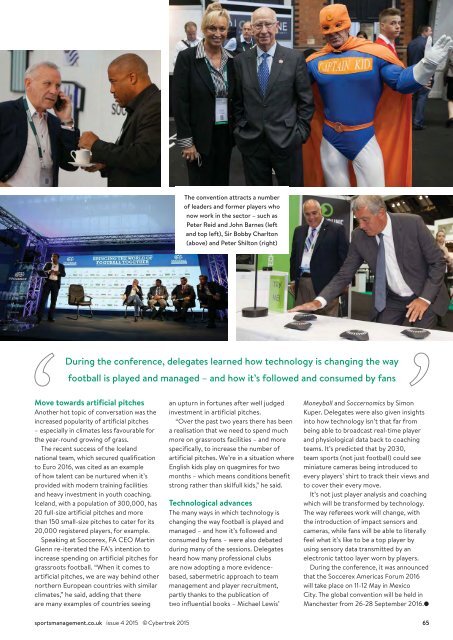EDDIE IZZARD
SM_issue4_2015
SM_issue4_2015
You also want an ePaper? Increase the reach of your titles
YUMPU automatically turns print PDFs into web optimized ePapers that Google loves.
The convention attracts a number<br />
of leaders and former players who<br />
now work in the sector – such as<br />
Peter Reid and John Barnes (left<br />
and top left), Sir Bobby Charlton<br />
(above) and Peter Shilton (right)<br />
Nequam, Catum mus, orum pris iaest perbis<br />
During the conference, delegates learned how technology is changing the way<br />
football is played and managed – and how it’s followed and consumed by fans<br />
Move towards artificial pitches<br />
Another hot topic of conversation was the<br />
increased popularity of artificial pitches<br />
– especially in climates less favourable for<br />
the year-round growing of grass.<br />
The recent success of the Iceland<br />
national team, which secured qualification<br />
to Euro 2016, was cited as an example<br />
of how talent can be nurtured when it’s<br />
provided with modern training facilities<br />
and heavy investment in youth coaching.<br />
Iceland, with a population of 300,000, has<br />
20 full-size artificial pitches and more<br />
than 150 small-size pitches to cater for its<br />
20,000 registered players, for example.<br />
Speaking at Soccerex, FA CEO Martin<br />
Glenn re-iterated the FA’s intention to<br />
increase spending on artificial pitches for<br />
grassroots football. “When it comes to<br />
artificial pitches, we are way behind other<br />
northern European countries with similar<br />
climates,” he said, adding that there<br />
are many examples of countries seeing<br />
an upturn in fortunes after well judged<br />
investment in artificial pitches.<br />
“Over the past two years there has been<br />
a realisation that we need to spend much<br />
more on grassroots facilities – and more<br />
specifically, to increase the number of<br />
artificial pitches. We’re in a situation where<br />
English kids play on quagmires for two<br />
months – which means conditions benefit<br />
strong rather than skilfull kids,” he said.<br />
Technological advances<br />
The many ways in which technology is<br />
changing the way football is played and<br />
managed – and how it’s followed and<br />
consumed by fans – were also debated<br />
during many of the sessions. Delegates<br />
heard how many professional clubs<br />
are now adopting a more evidencebased,<br />
sabermetric approach to team<br />
management and player recruitment,<br />
partly thanks to the publication of<br />
two influential books – Michael Lewis’<br />
Moneyball and Soccernomics by Simon<br />
Kuper. Delegates were also given insights<br />
into how technology isn’t that far from<br />
being able to broadcast real-time player<br />
and physiological data back to coaching<br />
teams. It’s predicted that by 2030,<br />
team sports (not just football) could see<br />
miniature cameras being introduced to<br />
every players’ shirt to track their views and<br />
to cover their every move.<br />
It’s not just player analysis and coaching<br />
which will be transformed by technology.<br />
The way referees work will change, with<br />
the introduction of impact sensors and<br />
cameras, while fans will be able to literally<br />
feel what it’s like to be a top player by<br />
using sensory data transmitted by an<br />
electronic tattoo layer worn by players.<br />
During the conference, it was announced<br />
that the Soccerex Americas Forum 2016<br />
will take place on 11-12 May in Mexico<br />
City. The global convention will be held in<br />
Manchester from 26-28 September 2016.●<br />
sportsmanagement.co.uk issue 4 2015 © Cybertrek 2015 65


